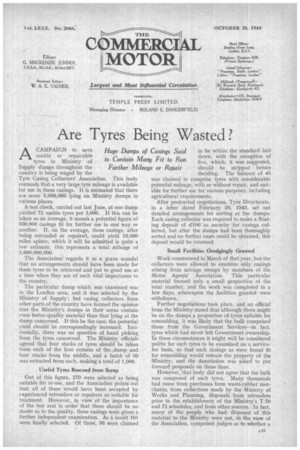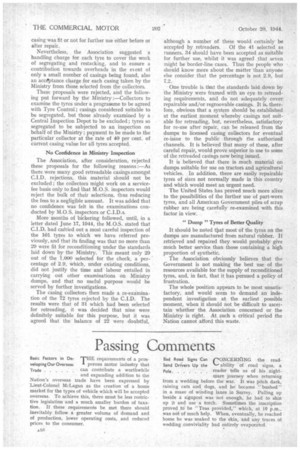Are Tyres Being Wasted , ?
Page 17

Page 18

If you've noticed an error in this article please click here to report it so we can fix it.
ACAMPAIGN to saVe usable or repairable tyres in Ministry of Supply dumps throughout the country is being waged by the Tyre Casing Collectors' Association. This body contends that a very large tyre mileage is available for use in these casings. It is estimated that there are some 5,000,000 lying on Ministry dumps in various places.
A test check, carried out last June, at one dump yielded 72 usable tyres per 1,000. If this can be taken as an average, it mean's a potential figure of 360,000 casings fit for further use in one way or another. If, on the average, these casings, after being retreaded or repaired, could yield 10,000 miles apiece, which it will be admitted is quite a low estimate, this represents a total mileage of 3,600,000,000.
The Associatiori regards it as a grave scandal that no arrangements should have been made for these tyres to be retrieved and put to good use at a time when they are of such vital importance to the country.
The particular dump which was examined was in the London area, and it Was selected by the Ministry of Supply ; but casing collectors from other parts of the country have formed the opinion that the Ministry's dumps in their areas contain even better-quality material than that lying at the dump concerned. If this be the case, the potential yield should be correspondingly increased. Incidentally, there was no question of hand picking from the tyres concerned. The Ministry officials agreed that four stacks of tyres should be taken from each of the four corners of the ,dump and four stacks from the middle, and a batch of 50 was extracted from each, ma,king a total of 1,000.
Useful Tyres Rescued from Scrap Out of this figure, 270 were selected as being suitable for re-use, and the Association points out that all of these would have been accepted by experienced retreaders or repairers as suitable for treatment. However, in view of the importance of the test and in order that there should be no doubt as to the quality, these casings were given a further independent examination. As a result 101 were finally selected. Of these, 56 were claimed to be within the standard laid down, with the exception of five, which, it was suggested, should be stripped before deciding. The balance of 45 was claimed to comprise tyres with considerable potential mileage, with or without repair, and suitable for further use for various purposes. including agricultural requirements.
After protracted negotiations, Tyre Directorate, in a letter' dated February 20, 1943, set out detailed arrangements for sorting at the dumps: Each casing collector was required to make a floating deposit of £100 as security for casings collected, but after the dumps had been thoroughly sorted and no further cases could be obtained, this deposit would be returned.
Small Facilities Grudgingly Granted Work commenced in March of that year, but the collectors were allowed to examine only casings arising from salvage sweeps by members of the Motor Agents' Association. This particular material formed only a small proportion of the total number, and the work was completed in a few days, whereupon the facilities granted were withdrawn.
Further negotiations took place, and an official from the Ministry stated that although there might be on the dumps a proportion of tyres suitable for remoulding, it was likely that the bulk comprised those from the Government Services—in fact, tyres which had never left Government ownership. In these circumstances it might well be considered politic for such tyres to be examined on a servicefee basis, so that such casings as were found fit for remoulding would remain the property of the Ministry, and the Association was asked to put forward proposals on these lines.
However, that body did not agree that the bulk was composed of such tyres. Many thousands had come from purchases from waste-rubber merchants, from collections made by the Ministry of Works and Planning, disposals from retreaders prior to the establishment of the Ministry's 1.70 and 71 schedules, and from other sources. In fact, many of the people who had disposed of this material to the Ministry were not, in the view of the Association, competent judges as to whether a casing was fit or not for further use either before or after repair.
Nevertheless, the Association suggested a handling charge for each tyre to cover the work of segregating and restacking, and to ensure a contribution towards overheads in the event of only a small number of casings being found, also an acceptance charge for each casing taken by the Ministry from those selected from the collectors.
These proposals were rejected, and the following put forward by the Ministry :—Collectors to examine the tyres under a programme to be agreed with Tyre Control ; casings considered suitable to be segregated, but those already examined by a Central Inspection Depot to be excluded ; tyres so segregated to be subjected to an inspection on behalf of the Ministry ; payment to be made to the particular collector at the rate of 40 per cent, of current casing value for all tyres accepted.
No Confidence in Ministry Inspection The Association, after consideration, rejected these proposals for the following reasons :—As there were many good retreadable casings amongst C.I.D. rejections, this material should not be excluded ; the collectors might work on a servicefee basis only to find that M.O.S. inspectors would reject the bulk of their selections, thus reducing the fees to a negligible amount. It was added that no confidence was felt in the examinations conducted by M.O.S. inspectors or C.I.D.s.
More months of bickering followed, until, in a letter dated June 17, 1944, the M.O.S. stated that C.I.D. had cat=ried out a most careful inspection of the 101 tyres to which we have referred previously, and that its finding was that no more than 29 were fit for reconditioning under the standards laid down by the Ministry. This meant only 29 out of the 1,000 selected for the check, a percentage of 2.9, which, under existing conditions, did not justify the time and labour entailed in carrying out other examinations on Ministry dumps, and that no useful purpose would be served by further investigations.
The casing collectors then made a re-examination of the 72 tyres rejected by the C.I.D. The results were that of 31 which had been selected for retreading, it was decided that nine were definitely suitable for this purpose, but it was agreed that the balance of 22 were doubtful, although a number of these would certainly be accepted by retreaders. Of the 41 selected as runners, 34 should have been accepted as suitable for further use, whilst it was agreed that seven• might be border-line cases. Thus the people who should know more about the matter than anyone else consider that the percentage is not 2.9, but 7.2.
One trouble is that the standards laid down by the Ministry were framed with an eye to retreading requirements, and do not adequately cover repairable and/or regroovable casings. It is, therefore, obvious that a system should be established at the earliest moment whereby casings not suitable for retreading, but, nevertheless, satisfactory for re-use after repair, can be released from the dumps to licensed casing collectors for eventual re-issue to the public through the authorized channels. It is believed that many of these, after careful repair, would prove superior in use to some of the retreaded casings now being issued.
It is believed that there is much material on dumps suitable for use on tractors and agricultural vehicle& In addition, there are easily repairable tyres of sizes not normally made in this country and which would meet an urgent need.
The United States has proved much more alive to the possibilities of the further use of part-worn tyres, and all American Government piles of scrap rubber are being carefully re-examined with this factor in view.
"Dump "Tyres of Better Quality It should be noted tbat most of the tyres on the dumps are manufactured from natural rubber. If retrieved and repaired they would probably give much better service than those containing a high proportion of synthetic.
The Association obviously believes that the Government is not making the best use of the resources available for the supply of reconditioned tyres, and, in fact, that it has pursued a policy of frustration.
The whole position appears to be most unsatisfactory, and would seem to demand an independent investigation at the earliest possible moment, when it should not be difficult to ascertain whether •the Association concerned or the Ministry is right. At such a critical period the Nation cannot afford this waste.




















































